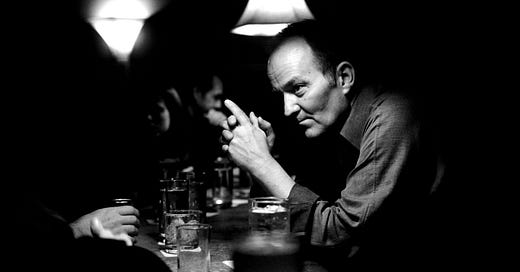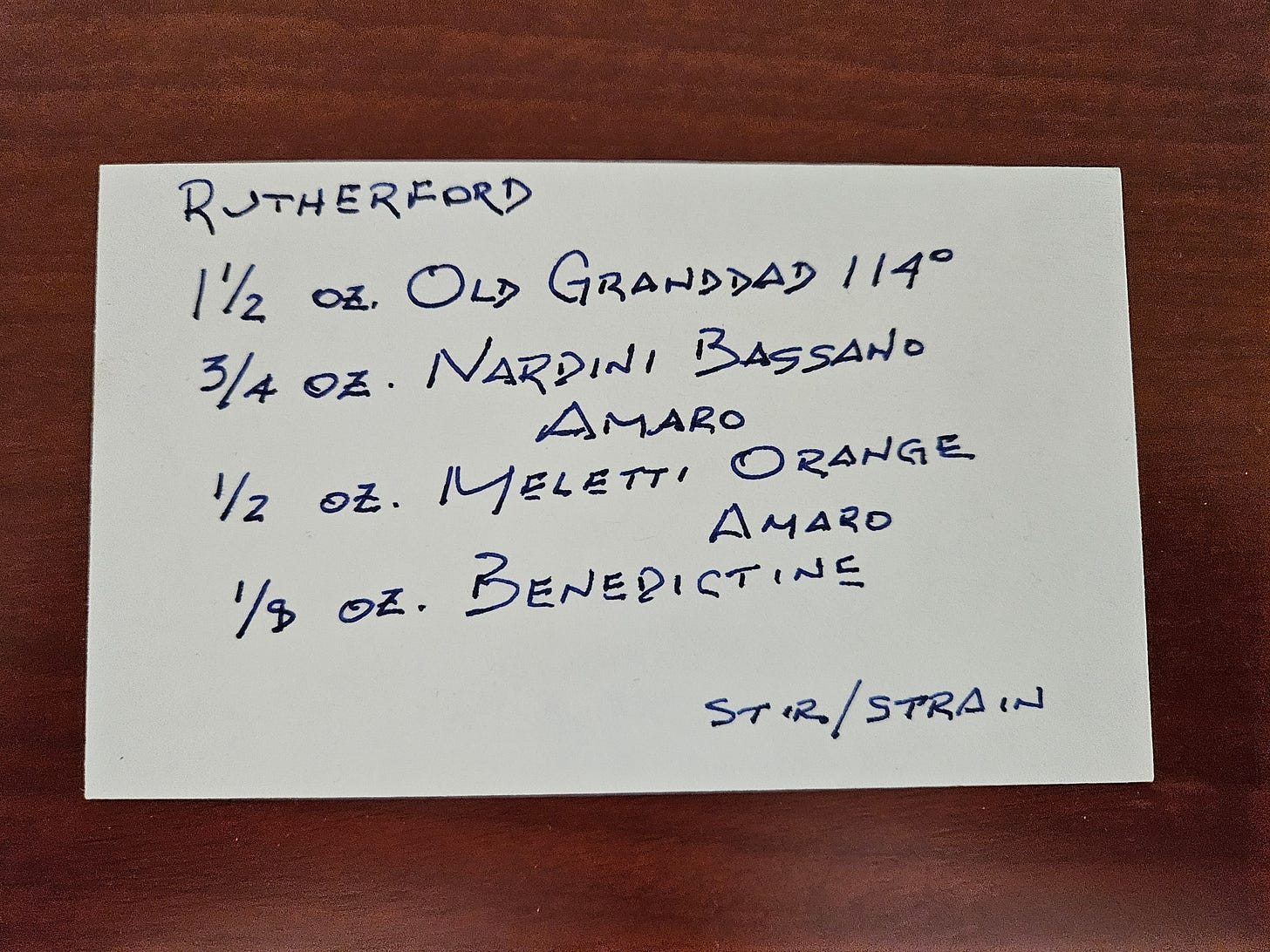Everyone who knew Murray Stenson, the bartender extraordinaire who passed away yesterday, has a story about how their paths first crossed. Here’s mine.
Rosemarie and I had become regulars at Seattle’s Zig Zag Café in the aughts without encountering Murray. On the face of it, that’s an absurd turn of events; Murray was already the Zig Zag’s top draw. But we had taken to dropping in early on Saturdays, one of the nights he wasn’t working. For weeks the other bartenders told us, “You’ve got to come see Murray.”
Finally we showed up on a weeknight. Murray bustled over to us immediately. “We meet at last,” he said.
It was the essence of how Murray plied his trade: instantly making you feel welcome, deflecting the focus from himself. We became fixtures on nights when Murray was working, at the Zig Zag and elsewhere, like so many other people.
Murray was among the last of the rarest breed, a bartending lifer. He never opened his own place, never became a brand ambassador. For almost forty years he simply practiced his craft, which he regarded first and foremost as the art of hospitality. Swank cocktail palace or hole-in-the-wall, it made no difference: Murray made any establishment feel like a place worth visiting. He possessed an encyclopedic memory, for both faces and drinks. His lasting legacy will be the revival of the Last Word, created at the Detroit Athletic Club during Prohibition. Murray unearthed the recipe from Ted Saucier’s 1951 book Bottoms Up! and put it on the Zig Zag’s menu. It would become, in the words of Jason Wilson in the Washington Post, “the Official Drink of the Classic Cocktail Renaissance.” Every recent article about the shortage of green chartreuse, an essential ingredient, mentions Murray and the Last Word.
More of Murray in action: during the pandemic, he had taken to holding court in a park near his home. We made arrangements to get together there one afternoon. “I’ll bring the glassware,” he said.
Silly me. I thought he was kidding.
When I arrived, Murray was waiting with a flask of Irish whiskey. He had, of course, brought two tumblers, wrapped in tissue paper. He had also thought to bring two bottles of water. (“Taj Mahal’s favorite brand,” Murray said, mentioning the blues musician. “If it’s good enough for him, it’s good enough for me.”) That day also marked the first and still only time I saw a Seattle police officer walking a beat. As he drew closer to us—two guys clearly drinking liquor in a public park—I was certain we were about to get busted. The officer looked us over, said, “Gentlemen,” and went on his way. It was a perfect afternoon.
Murray had an outsized impact on bartending culture, not only in the Pacific Northwest but globally, because of the many people he influenced. Other bartenders regularly sought him out, and he passed along his knowledge readily. Stories abound of him pressing copies of vintage cocktail books on others, and I can tell my share; much of my own collection came from him.
He did all of this quietly. He once told me part of him still believed that if you called attention to yourself behind the bar, you weren’t doing the job properly. But legions of people, chief among them his colleagues, noticed and valued everything he did. In 2010, he was named Best Bartender in America at the annual Tales of the Cocktail conference. He didn’t go to New Orleans to receive the award; instead, he worked at the Zig Zag that night. I asked him about the honor, and he quoted John Huston’s line in Chinatown about politicians, ugly buildings, and whores all getting respectable if they lasted long enough. “I like to think of myself as the ugly building of American bartending,” he said.
Over the years, I was fortunate enough to get to know Murray outside of the bar. We’d meet up for coffee, lunch, cocktails, sometimes all three, and talk about politics, music—he was a hardcore audiophile—old movies, and crime fiction. He asked about James Crumley once, and let slip that the novelist would mark the completion of a new book by driving from Montana to Seattle and stopping in to visit Murray wherever he was working. If any bartender could have made room for Fireball Roberts, the beer-drinking bulldog who appears in Crumley’s landmark The Last Good Kiss (1978), it was Murray.
Fascinated by his approach to his work, I asked Murray if he’d ever thought about writing his own book. He shrugged and said yes, but he wasn’t interested in assembling another collection of cocktail recipes. He wanted to go deeper, to write about what his decades behind the bar had taught him, about his philosophy of hospitality. With, naturally, a few recipes. I proposed that this was a project we could work on together. To my amazement, he agreed.
I interviewed this intensely private man about his life and career, although to be honest we spent a lot of time talking about The Rockford Files. I assembled a proposal with sample chapters that we were both happy with. The reaction from publishers was good, but not what we wanted. With Murray’s name, we were told, it made more sense to do that simple collection of cocktail recipes. We talked about pulling it together, weaving in some of the life lessons, but then Murray began dealing with health issues, and the pandemic happened.
It will always be a huge regret that the book didn’t come together, that I didn’t get to put into words what Murray put into practice every night. But I’ll remember those hours we spent together.
In one of those conversations, I asked about opening a bar, and he said that to begin with, you have to know what kind of bar you’re opening. It’s a piece of advice that seems simple and specific, but can be applied universally. I think of it whenever I’m about to undertake a new project. I’ve shared it with others and seen it resonate with them. At its core, it poses multiple essential questions. What is it that I want to say? How can I say it truthfully? How do I welcome others into it? That combination of intention, authenticity, and awareness is how Murray did his job for almost four decades.
Last night I went to Il Bistro, where the legend of Murray Stenson began. I ordered a Rutherford, one of his original drinks, still on the menu. Then I went to the Zig Zag for a Porteño, another of his creations. At both bars, we shared stories, shed tears, and revealed more of ourselves to complete strangers than we thought we would. It was the kind of night Murray regularly made possible, the kind he would have loved.
Brad Thomas Parsons offers his own reminiscence of Murray.
What I’m Drinking
It’s an all-Murray edition, starting with the Last Word, which Murray saved from obscurity. Here’s how he gave me the recipe.
The Last Word
¾ oz. gin, the bolder the better
¾ oz. maraschino
¾ oz. green chartreuse
¾ oz. lime juice
Shake. Strain. No garnish.
A few years ago, Murray was rereading Raymond Chandler’s The Big Sleep and General Sternwood’s line to Philip Marlowe about the brandy he’d just served the shamus struck him: “I used to like mine with champagne. The champagne as cold as Valley Forge and about a third of a glass of brandy beneath it.” He turned it into a cocktail and put it on the list at Il Bistro, where it became a hit.
The General Sternwood
1 oz. brandy (Murray was partial to Park cognac)
4 ½ – 5 oz. champagne, depending on taste
He named the Rutherford after a fellow bartender.
The Rutherford
1 ½ oz. Old Grand Dad 114 bourbon
¾ oz. Nardini Bassano amaro
½ oz. Meletti Orange amaro
1/8 oz. Benedictine
Stir. Strain. No garnish.
Lastly, another Zig Zag original.
The Porteño
¾ oz. bourbon (robust)
¾ oz. Fernet Branca
¾ oz. Cherry Heering
¾ oz. lime juice
½ oz. simple syrup OR falernum OR Pylernum (the Zig Zag’s own version of falernum)
Shake. Strain. No garnish.






